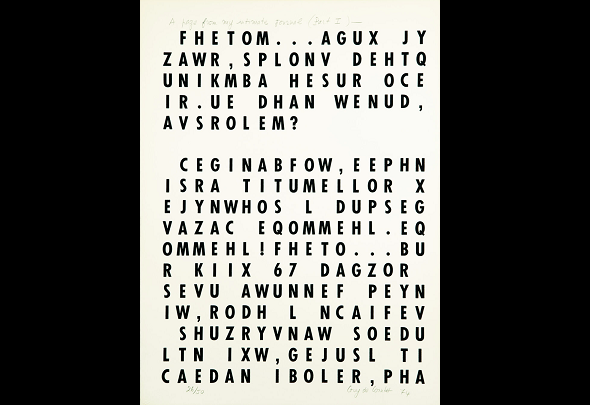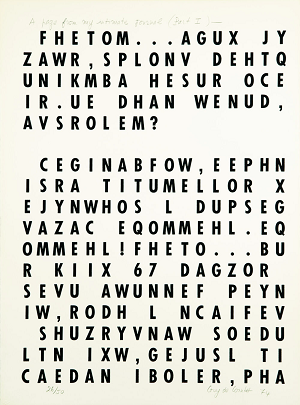Der Künstler Guy de Cointet hat viele verschlüsselte Werke hinterlassen. Auf eines davon – dem Titel nach handelt es sich um einen Tagebuch-Auszug – will ich heute näher eingehen.
English version (translated with DeepL)
Ich finde es nach wie vor erstaunlich, dass der französisch-amerikanische Künstler Guy de Cointet (1934–1983) in der Krypto-Szene nahezu unbekannt ist.
Guy de Cointet
De Cointet wurde in Paris geboren und wanderte 1966 in die USA aus. Er lebte in New York und Los Angeles, wo nahezu alle seine Werke entstanden. Er starb im Alter von nur 49 Jahren. Es gibt einen Wikipedia-Eintrag und eine Webseite zu seiner Person.
Wie ich vor Kurzem berichtet habe, hat de Cointet zahlreiche Bilder geschaffen, auf denen verschlüsselte Texte zu sehen sind.
Einem Artikel in der Los Angeles Times aus dem Jahr 2021 zu Folge entwickelte sich de Cointets Interesse an der Kryptografie bereits in seiner Jugend. Zu seinem Privatleben hielt er sich stets bedeckt. Er trat nie mit einer Partnerin oder einem Partner in Erscheinung. Sein offenkundiges Interesse an verschlüsselten Botschaften und seine zurückgezogene Lebensweise führten zu Spekulationen, dass er ein Spion war. Ernsthafte Belege dafür gibt es allerdings nicht. Sein früher Tod ist auf eine Hepathitis-C-Erkrankung zurückzuführen.
Während Kryptologie-Interessierte de Cointet bisher kaum beachtet haben, hat es der Wahl-Amerikaner in der Kunstszene inzwischen zu einem gewissen Ansehen gebracht – wenn auch hauptsächlich nach seinem frühen Tod. Der 2013 erschienene Los-Angeles-Times-Artikel berichtet über zahlreiche Museen und Ausstellungen, die de Cointets Werke ins Programm genommen haben. Auch das Museum of Modern Art (MOMA )in New York, das wohl bedeutendste Museum für moderne Kunst überhaupt, besitzt eine Reihe von Bildern von ihm.
A Page From My Intimate Journal (Part 1)
Bereits in meinem letzten Artikel über de Cointet habe ich über das folgende Bild berichtet:
Es heißt “A Page From My Intimate Journal (Part 1)” und ist 1974 entstanden. Der gezeigte Scan ist unten links mit “26/50” markiert, was darauf hindeutet, dass es 50 Exemplare dieses Werks gibt. Tatsächlich habe ich mehrere Versionen davon auf Google Images gefunden. Einige davon haben ebenfalls die Aufschrift “xy/50”. Es gibt aber auch eines mit der Aufschrift “Cirrus Proof” (also wohl ein Probedruck) und eines mit “A/P”.
Ein “Part 2” dieses Werks konnte ich nirgends finden.
Das Kryptogramm
Zeigt das Bild tatsächlich einen Auszug aus einem “intimen Tagebuch”, wie der Titel vermuten lässt? Ist der Text verschlüsselt? Ich weiß es nicht. Hier ist zunächt einmal eine Transkription:
_FHETOM...AGUX JY
ZAWR,SPLONV_DEHTQ
UNIKMBA_HESUR_OCE
IR.UE_DHAN_WENUD,
AVSROLEM?
_CEGINABFOW,EEPHN
ISRA_TITUMELLOR_X
EJYNWHOS_L_DUPSEG
VAZAC_EQOMMEHL.EQ
OMMEHL!FHETO...BU
R_KIIX_67_DAGZOR
SEVU_AWUNNEF_PEYN
IW,RODH_L_NCAIFEV
_SHUZRYVNAW_SOEDU
LTN_IXW,GEJUSL_TI
CAEDAN_IBOLER,PHA
Und hier ist eine mit CrypTool 2 erstellte Häufigkeitsanalyse (natürlich kann man auch Multi-Dec von Blog-Leser Christian Baumann verwenden):
Wie Blog-Leser Thomas Bosbach richtigerweise bemerkt hat, sieht das stark nach einer Transpositionschiffre und einem englischen Klartext aus. Nur das T kommt unerwartet selten vor.
Eine spaltenweise Transposition kann es kaum sein, da sich sonst die Leerzeichen in der fünften Zeile nicht alle am Ende befinden würden.
Dass der Text wortweise anagrammiert wurde, kann ebenfalls nicht sein, da sich ein Ausdruck wie L oder UE nicht zu einem sinnvollen Wort umordnen lässt.
Ein interessanter Kommentar kam von Norbert Biermann. Er sieht mögliche Anspielungen: “Wenn ich etwa DUPSEG VAZAC lese, muss ich unwillkürlich an Alexander Dubček und Václav Havel denken. Im Entstehungsjahr 1974 war der Prager Frühling noch nicht so lange her, so gesehen würde das passen.”
Norberts Fazit: “Ich halte es für gut möglich, dass Cointet ganz bewusst die Buchstabenhäufigkeiten so gewählt und die Vokale größtenteils ‘sinnvoll’ verteilt, aber trotzdem keinen echten Klartext zugrunde gelegt hat.”
Falls “A Page From My Intimate Journal (Part 1)” entschlüsselbar ist, muss de Cointet ein komplexeres Verfahren als bei vielen seiner anderen Verschlüsselungen verwendet haben, die längst gelöst sind. Kann ein Leser dieses Gemälde trotzdem entschlüsseln?
Follow @KlausSchmeh
Further reading: Steganografische Nachricht aus dem Zweiten Weltkrieg gelöst
Linkedin: https://www.linkedin.com/groups/13501820
Facebook: https://www.facebook.com/groups/763282653806483/






Kommentare (6)